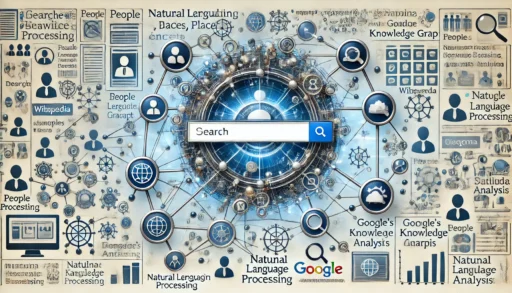Entity Usage for Search Engine Optimization (SEO) refers to the modern approach of optimizing web content by focusing on entities rather than solely relying on traditional keyword methods. In this context, an entity is a distinct concept or object recognized within a knowledge graph, such as Google’s Knowledge Graph, which collects information from various sources to enhance search results. This shift from keyword-centric to entity-centric SEO marks a significant evolution in search engine practices aimed at improving the relevance and accuracy of search results by providing context through interconnected entities [1][2].
Historically, SEO strategies were predominantly keyword-driven, emphasizing meticulous content writing, strategic anchor text usage, and diligent Search Engine Results Pages (SERPs) tracking to boost website visibility [1]. However, over the past decade, advancements in search engine technology, particularly the introduction of the Knowledge Graph, have led to a more sophisticated understanding of the web as a network of interconnected entities [3]. This has given rise to entity-based SEO, which seeks to optimize content by linking relevant entities to their corresponding knowledge base entries, thus providing better context and enhancing search engine rankings [4][5].
The implementation of entity SEO involves techniques such as Named Entity Recognition (NER), entity linking, and disambiguation. These methods enable search engines to interpret and categorize content more effectively, aligning it with user intent and improving the overall user experience [6][7]. By leveraging entities, SEO practitioners can create more contextually rich and user-centric content, which is increasingly favored by search algorithms like Google’s [8].
Despite its advantages, the concept of entity SEO has not been widely adopted or fully understood within the SEO community. This is partly due to the overlap with traditional keyword optimization and the interchangeable use of terms like “entities” and “topics” by search engines, which can create confusion [5][9]. Nonetheless, as search engines refine their algorithms and enhance their understanding of the web, entity-based SEO is expected to play a crucial role in maintaining and improving website rankings [10][11]. The future of SEO lies in embracing this evolution, with entities forming the cornerstone of effective and resilient search optimization strategies.
Historical Overview of SEO

Search Engine Optimization (SEO) has undergone significant transformations since its inception. Initially, SEO focused on keyword-driven strategies, optimizing content by using specific keywords to improve search engine rankings. These early practices included meticulous content writing, strategic use of anchor text in links, and tracking Search Engine Results Pages (SERPs) [1]. The goal was to match search queries as closely as possible to predefined keywords, broadly defining the success of a website’s visibility.
However, over the past decade, the landscape of SEO has dramatically evolved. Modern SEO practices have shifted towards a more sophisticated understanding of the digital world. Search engines have moved from viewing the web merely as a string of words to recognizing it as a series of interconnected entities [1]. This transition marks the foundation of entity-based SEO, a strategy that is seen as future-proof in the realm of search optimization. Entities refer to distinct concepts or objects that are interconnected within a knowledge graph, such as Google’s Knowledge Graph, which collects information from various sources to enhance search results [2][3].
Entity SEO emphasizes the importance of understanding and linking relevant entities to their corresponding knowledge base entries. This method helps optimize content for search engines, thereby bolstering search engine rankings and amplifying organic traffic [4]. By employing techniques such as Named Entity Recognition (NER), entity linking, and disambiguation, SEO practitioners can provide search engines with better context, allowing for more accurate search intent matching and improved user experience [5][6][7].
The introduction of Google’s Knowledge Graph has been a pivotal development in SEO. The Knowledge Graph, which serves relevant information in an infobox beside search results, allows users to obtain answers at a glance. This shift towards instant answers has changed how search results are presented, moving beyond traditional blue links to include various content types such as videos, stories, and information panels [8][3]. Google’s ability to map well-defined entities across verified sources like Wikipedia, Wikidata, and the CIA World Factbook enables it to deliver precise and contextually relevant search results [9].
Understanding Entity Usage for Search Engine Optimization

Entity SEO is a modern approach to search engine optimization that focuses on optimizing for entities rather than solely relying on traditional keyword methods. Despite its significance, many SEOs struggle with the concept for various reasons. Firstly, the term “Entity SEO” has not been widely adopted in the SEO community, making it difficult for practitioners to integrate it into their vocabulary and workflows[5]. Additionally, optimizing for entities often overlaps with traditional keyword optimization, leading to confusion [5][10].
Entities are the building blocks of information search engines use to understand and categorize content. They are distinct from keywords and more akin to concepts or topics encompassing multiple keywords[5][11]. For example, the entity “New York City” could include keywords such as “NYC,” “Big Apple,” and “Manhattan,” but it represents a single, unified concept.
Search engines like Google utilize various techniques to identify and interpret entities within a user’s query, including natural language processing (NLP), machine learning, and semantic analysis[12]. These technologies allow search engines to create interconnected knowledge graphs, such as Google’s Knowledge Graph, which enhance search results by providing context and linking related entities[2][13].
Understanding the difference between keywords and entities is crucial for effective content marketing. While keywords are specific terms that users search for, entities provide a broader context that helps search engines deliver more relevant results[11]. This shift from keyword-centric to entity-centric optimization reflects the evolution of SEO toward creating user-centric and contextually relevant content[14][15].
Entities such as share of voice, keyword rankings, and content quality are essential for improving SEO metrics [12]. By focusing on entities, SEOs can better align their content with user intent and provide comprehensive information that addresses the searcher’s needs[15]. This approach enhances the user experience and improves search engine rankings by making content more discoverable and relevant[16].
Incorporating entities into your SEO strategy involves several key practices. First, it is essential to identify and include semantically related words on your pages[5]. Second, entity analysis tools can help you understand how search engines interpret your content and identify important entities[17]. Finally, aligning your content with your business goals and keeping your target audience in mind will ensure that your entity optimization efforts are effective and impactful[7][4].
How Search Engines Utilize Entities

Entity-based search is a more accurate method for search engines to understand search intent because Google can map well-defined entities across verified sources like Wikipedia that contribute to Google’s Knowledge Graph[6]. By linking objects defined as entities in website content to a search engine’s knowledge graph, content creators create more context for their content, helping Google better match it to user intent[6].
Entities have become vital in improving SEO, enhancing keyword rankings, and elevating the quality of content. Search engines use various techniques to identify entities in a user’s query and return relevant results. These techniques include natural language processing (NLP), machine learning, and semantic analysis[12]. With the implementation of these techniques, entity-based search phrases have largely replaced keyword-based searches from a semantic perspective, providing a more refined understanding of search intent and relevant content matching[7].
Google’s Knowledge Graph plays a critical role in this process. It is an extensive database of information that allows Google to provide immediate answers to user queries about real-world topics, known as entities[12]. By cataloging and mapping well-defined entities across verified sources, Google enhances its Knowledge Graph’s ability to serve relevant information directly within the search results[7]. This approach helps connect businesses and users interested in their products and services[7].
One example of a tool that supports entity optimization is Entity Clouds, which leverages bot crawl patterns and classification systems to align with search engine requirements[18]. This tool uses Internet database classification systems and structured data to strengthen the association between a business and authoritative entities[18]. By optimizing for entities, content can perform better in search engines, leading to improved visibility and search results[18].
The Google Knowledge Graph serves as a base from which Google provides relevant information in an infobox besides its search results. This allows users to see answers at a glance, improving user experience and reducing the need to click through to external sites[3]. The Knowledge Graph draws information from reliable sources like Wikipedia, Wikidata, and the CIA World Factbook, mapping relationships between entities to generate comprehensive knowledge panels[9].
Furthermore, knowledge graphs influence link-building and on-site SEO by encouraging links between known entities and relevant content rather than using arbitrary anchor texts[19]. This helps create a more cohesive and contextually relevant web of information, which benefits search engines and users. Structured data markup, though not conclusively proven to affect rankings, has shown indications of improving click-through rates by enhancing the visibility and informativeness of search results[20].
Entity Optimization Strategies for SEO

Entity optimization strategies for SEO leverage semantic search principles and entity-based search approaches to enhance content visibility and ranking in search engines.
Semantic Relevance and Context
One of the fundamental strategies in entity optimization is ensuring the semantic relevance and contextual richness of your content. Search engines prioritize content relevant to search queries and rich in context. By linking entities within your content to their corresponding knowledge base entries, such as Wikipedia or Wikidata, you can improve search engines’ semantic understanding of your content. This practice helps bolster search engine rankings and amplifies organic traffic to your website[4].
Personalization and Targeting

Entity linking empowers you to comprehend the context of your content comprehensively, enabling you to segment your audience with finesse. This segmentation allows you to deliver tailored content to distinct customer groups, thereby increasing the likelihood of conversions and customer satisfaction[4]. Understanding the entities your prospects and clients are looking for when they search can guide your content strategy and make it more user-focused[11].
Named Entity Recognition (NER)
When optimizing with schema, engaging in Named Entity Recognition (NER) is crucial, which includes entity identification, extraction, and chunking. NER helps distinguish and categorize proper nouns and other significant entities within your content. This process, often called entity disambiguation or wikification, links entities to structured databases, enhancing the association between your content and relevant entities[5].
Structured Data Markup
Structured data markup, such as Schema.org, is critical in entity optimization. It helps search engines understand the specific content on your page by providing structured information. This can lead to more relevant and informed searches and potentially enhanced results like featured snippets, rich snippets, and knowledge panels[21]. Implementing structured data correctly can significantly improve the semantic relevance of your content and its visibility in search engine results[22].
Enhancing Content Recommendations
Linking entities within your content provides valuable insights into the relationships between various topics and concepts. This can improve your content recommendation systems, making it easier for users to discover related content on your site. Improved content recommendations can increase user engagement and retention[4].
Adapting to Algorithm Changes

Optimizing for entities helps ensure that your website remains resilient to algorithm changes. As search engines like Google and Bing continue to enhance their understanding of the web and its content, having a strong entity-based SEO strategy can help maintain and improve your website’s rankings despite these changes[18]. By focusing on entities, you align your content strategy with the evolving nature of semantic search engines, which view content through the lens of known entities[18].
Utilizing Entity Analysis Tools
Employing entity analysis tools can help inspect your text for known entities and return valuable information about them. These tools can identify public figures, landmarks, and other significant entities within your content, assisting in refining your entity optimization efforts. Leveraging APIs such as the Google Knowledge Graph can further aid in predictively completing entities in search boxes and organizing content more effectively[17][23].
By integrating these strategies, you can optimize entities within your SEO efforts, enhancing content visibility, search engine rankings, and overall user engagement.
Measuring Entity Optimization Impact

Measuring the impact of entity optimization involves various approaches, including analyzing how well entities are recognized and linked within your content. One of the primary methods used in this process is Named Entity Recognition (NER), also known as entity identification, entity extraction, and entity chunking. This technique enables the disambiguation, wikification, and linking of entities, helping search engines understand and classify content more effectively[5].
A critical aspect of evaluating entity optimization is using tools and technologies that facilitate this process. For instance, Entity Clouds leverages the science of bot crawl patterns and classification systems to enhance the association between a business and authoritative entities. This programmatic tool set can be integrated using Google Tag Manager (GTM) or a WordPress plugin, providing a structured approach to improving search engine recognition of relevant entities[18].
Entity Analysis, another essential tool, inspects text for known entities such as public figures and landmarks and returns detailed information about them. This process is crucial for understanding how well your content aligns with recognized entities. It can be performed using methods like analyzeEntities, as outlined in the documentation provided by natural language processing platforms[17].
The impact of entity optimization extends beyond mere content recognition; it plays a pivotal role in personalization and targeting. By linking relevant entities to their corresponding knowledge base entries, content creators can segment audiences more precisely and deliver tailored content that enhances user satisfaction and conversion rates[4]. This entity linking also boosts SEO by ensuring that content is semantically rich and contextually relevant, thereby improving search engine rankings and increasing organic traffic[4].
Furthermore, the effectiveness of entity-based SEO is evident in its ability to maintain content relevance through algorithm changes. As search engines like Google and Bing continuously refine their understanding of the web, entity-optimized content is more likely to sustain high rankings, demonstrating the long-term benefits of this approach[18].
Ultimately, measuring the impact of entity optimization requires a comprehensive understanding of how entities interact with search engines and how tools and techniques can be utilized to maximize these interactions. Businesses can better align their content with search engine expectations by focusing on entity recognition, linking, and analysis, improving rankings and greater visibility[15].
Challenges in Entity Usage for Search Engine Optimization
Entity optimization for SEO presents several challenges that SEOs must navigate to enhance their search strategies effectively. One significant hurdle is the ongoing confusion and conflation between entities and traditional keywords. Despite the increased emphasis on entities in modern SEO, the industry has not fully adopted or become comfortable with the term “Entity SEO” [7][5]. This confusion arises partly because entities and keywords overlap significantly in optimization methods, leading to misconceptions and misapplications in SEO practices [5][11].
Another challenge is the ambiguity surrounding the role of entities within SEO. Google and other search engines often use the term “entities” interchangeably with “topics,” further muddying the waters for SEOs attempting to distinguish between the two [5]. This lack of clarity complicates the optimization process, as SEOs strive to balance keyword relevance while integrating entity-based approaches effectively.
The technical aspect of entity optimization also poses difficulties. Implementing schema markup to optimize for Named Entity Recognition (NER) involves complex tasks such as entity identification, extraction, and disambiguation [5]. This process requires SEOs to continuously update their schema markups and ensure they accurately represent the entities on their web pages [6].
Moreover, integrating knowledge graphs and ontologies into SEO strategies demands a comprehensive understanding of how these tools organize and interrelate information. Knowledge graphs represent networks of real-world entities and their relationships, while ontologies provide a formal representation based on taxonomies [24][25]. The distinction between these concepts and their proper application is critical but can be challenging for SEOs to master [25].
Finally, the industry is still evolving in terms of understanding and applying entity optimization. As noted by experts, much remains to learn about how entity signals will increase prominence and influence search engine rankings [26]. As SEOs continue to adapt, the importance of entities will likely expand, necessitating ongoing education and adaptation to keep pace with the latest developments in search algorithms and entity-based strategies [26][1].
Future Perspectives on Entity Usage for Search Engine Optimization
Entity SEO is increasingly recognized as the future direction for search engine optimization. This is largely due to its potential to improve the accuracy and relevance of search results by leveraging the connections between concepts rather than relying solely on keywords[5].
Optimizing for entities involves using schema to enhance Named Entity Recognition (NER), which is crucial for search engines like Google and Bing better to understand the content and its context [5]. This method, known as Named Entity Disambiguation, includes processes such as Wikification and Entity Linking[5].
Despite the significance of entities, many SEOs are still confused about their role due to the overlap with traditional keyword-focused methods. The terminology hasn’t been widely adopted, making it difficult for SEOs to incorporate it into their vocabulary and practices[5]. Additionally, Google’s interchangeable use of “entities” and “topics” further muddies the waters[5].
The shift towards entity-based SEO is part of a broader trend toward semantic search, which was significantly advanced by algorithm updates like Hummingbird and RankBrain[27]. These updates emphasize understanding the meaning behind searches, making entity SEO
References for Entity Usage for Search Engine Optimization
[1]: Entities In SEO: What Are They And Why Do They Matter?
[2]: What is the Difference Between Keywords and Entities? – Syntactics Inc.
[3]: Google Knowledge Graph – Wikipedia
[4]: How Entity Linking Can Boost Your Search Performance
[5]: Entity SEO: The definitive guide
[6]: Entity-Based SEO for Advanced Search | Schema App Solutions
[7]: Query Entities Discovery and Keyword Research
[8]: How Search Engines Rank Pages
[9]: Google Knowledge Graph: What It Is & Why It Matters
[10]: An SEO’s Guide to Entities and How to Use Them | iloveseo.com
[11]: Entities In SEO: How Topic Research & Natural Language Processing Will Shape
SEO Content | SEO Scout
[12]: How to Use Entity SEO to Rank Higher in Google
[13]: What is a Knowledge Graph? | Ontotext Fundamentals
[14]: What Is Semantic Search and How Does it Affect SEO
[15]: Semantic Search: What It Is and Why It Matters for SEO
[16]: Build a Smarter Knowledge Graph to boost SEO – WordLift Blog
[17]: Analyzing Entities | Cloud Natural Language API | Google Cloud
[18]: How to optimize for entities
[19]: Google’s Knowledge Graph and How it Impacts SEO | iloveseo.com
[20]: What Is Schema Structured Data And How To Implement It – Moz
[21]: The Beginner’s Guide to Structured Data for Organizing & Optimizing Your Website
[22]: How to Optimize Your Structured Data for SEO and Semantic SEO
[23]: Google Knowledge Graph Search API | Google for Developers
[24]: What is a Knowledge Graph? A comprehensive Guide – WordLift Blog
[25]: What Is a Knowledge Graph? | IBM
[26]: Content optimization using entities: An actionable guide
[27]: What Exactly Is Semantic Search (& How Does it Affect SEO)

